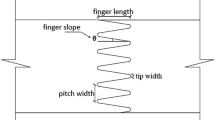Abstract
This research work presents a study on the finger jointing of green Black pine wood (Pinus nigra L.) using a phenol resorcinol formaldehyde adhesive. The effect of finger joint orientation (vertical or horizontal fingers) was also examined. In general, the results from the measurements of modulus of rupture and modulus of elasticity of green glued finger-jointed specimens indicated that green gluing of Black pine wood is feasible.
Similar content being viewed by others
References
Baxter GF, Kreibich RE (1973) A fast-curing phenolic adhesive system. For Prod J 23(1):17–22
Currier RA (1960) Finger jointing at high moisture content. For Prod J 10(6):287–293
DIN 52186 (1978) Testing of wood; bending test. DIN German Institute for Standardization
Elbez G (2006) A new pilot plant for finger-jointing green maritime pine in France. Announcement in COST action E34 meeting, working group II, 27–28 Sept., Brussels, Belgium
EN 385 (2001) Finger jointed structural timber: performance requirements and minimum production requirements. British Standards Institution
ISO 10983 (1999) Timber structures—solid timber finger-jointing—production requirements. ISO International Organization for Standardization
Kreibich RE (1974) High speed adhesives for the wood gluing industry. Adhes Age 17:26–33
Kreibich RE, Hemingway RW (1985) Condensed tannin-resorcinol adducts in laminating adhesives. For Prod J 35(3):23–25
Kreibich RE, Hemingway RW (1987) Condensed tannin-sulfonate derivatives in cold-setting wood laminating adhesives. For Prod J 37(2):43–46
Kreibich RE, Steynberg PJ, Hemingway RW (1998) End jointing green lumber with SoyBond. In: Proceedings of 2nd biennial residual wood conference, Swanson JS, November 4–5, Richmond, BC, USA, pp 28–36
Lipke M (2005) Green glued fingerjoint wall studs: industrial experience of Hampton Lumber Mills. In: Källander, B (ed), Proceedings of COST action E34 international workshop “Green gluing of wood: process, products, market”, 7–8 April 2005, Böras, Sweden, pp 91–98
Maun K, Cooper G (1999) Re-engineering softwood for constructional use by wet (green) gluing. In: Berti, S, Macchioni, N, Negri, M, Rachello, E (eds), Proceedings of eurowood technical workshop “Industrial end-uses of fast-grown species”, Florence, Italy, pp 47–59
Murphey WK, Nearn WT (1956) Effect of moisture content on the appearance of resorcinol glue lines in laminated oak lumber. For Prod J 6:194–197
Parker JR, Taylor JB, Placket DV, Lomax RE (1991) Method of joining wood. US Patent No 5,674,338
Parker JR (1994) Greenweld process for engineered wood products. In: Proceedings of the int panel and engineered wood technology exposition, 5 Oct. 1994, Atlanta, Georgia, USA, pp 10–17
Pizzi A, Roux DG (1978) The chemistry and development of tannin-based weather- and boil- proof cold setting and fast-setting adhesives for wood. J Appl Polym Sci 22:1945–1954
Pizzi A, Cameron FA (1984) Fast-set adhesives for glulam. For Prod J 34(9):61–68
Pommier R, Coureau JL, Legrand G (2005) Finger jointing of green maritime pine timber: evaluation of different adhesives and determination of resulting bending strength. In: Källander B (ed), Proceedings of COST action E34 international workshop “Green gluing of wood: process, products, market”, 7–8 April 2005, Böras, Sweden, pp 48–54
Raknes E (1967) Fingerjointing with resorcinol glues at high wood moisture content. Report No 32, The Norwegian Institute of Wood Working and Wood Technology, Blindern, Norway
Sterley M (2004) Green gluing of wood. Licentiate thesis. Department of Civil and Architectural Engineering, KTH—Royal Institute of Technology, Stockholm, Sweden
Strickler MD (1970) End gluing of green lumber. For Prod J 20(9):47–51
Tiedeman GT, Sanclemente MR (1973) The chemistry of fast-curing phenolic adhesives: part I. J Appl Polym Sci 17:1813–1818
Tiedeman GT, Sanclemente MR, HA Smith (1973) The chemistry of fast-curing phenolic adhesives: part II. J Appl Polym Sci 17:1819-1832
Troughton GE, Chow S (1980) Finger jointing kiln dried and unseasoned white spruce lumber using the WFPL method. For Prod J 30(12):48–49
Acknowledgements
This work was funded by the Greek National Ministry of Education (EPEAEK) through “Archimedes ⋅ Programme II”, which is highly acknowledged. The authors wish to thank Dynea ASA for the kind supply of the glue and hardener used.
Author information
Authors and Affiliations
Corresponding author
Rights and permissions
About this article
Cite this article
Mantanis, G., Karastergiou, S. & Barboutis, I. Finger jointing of green Black pine wood (Pinus nigra L.). Eur. J. Wood Prod. 69, 155–157 (2011). https://doi.org/10.1007/s00107-010-0435-9
Received:
Published:
Issue Date:
DOI: https://doi.org/10.1007/s00107-010-0435-9




